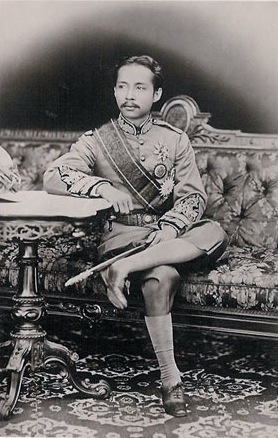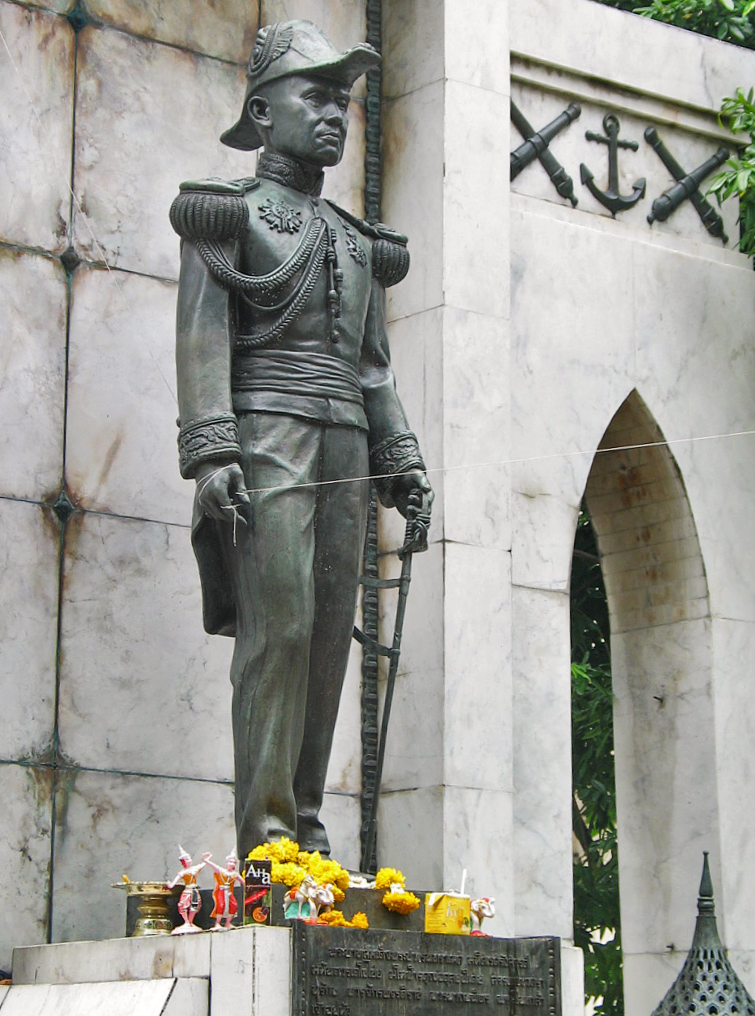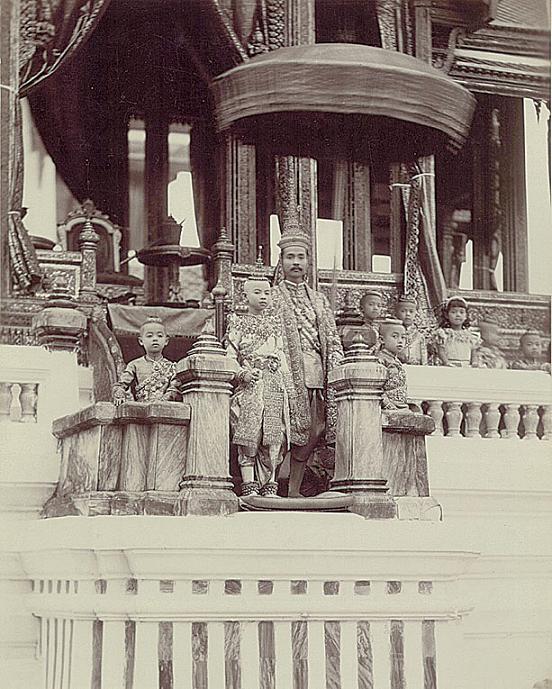|
Vichaichan
Krom Phra Ratchawang Bowon Wichaichan ( th, กรมพระราชวังบวรวิไชยชาญ) or Phra Ong Chao Yodyingyot (or Yingyot) (พระองค์เจ้ายอดยิ่งยศ) (6 April 1838 – 28 August 1885) was a Thailand, Siamese Prince and member of the Chakri Dynasty. He was the eldest son of Viceroy Pinklao and Princess Aim, and thus nephew to King Mongkut (Rama IV). Wichaichan succeeded his father by being appointed the Front Palace and ''Viceroy of Siam'' in 1868, during the reign of his cousin King Chulalongkorn (Rama V).Kesboonchoo Mead P.38 During his tenure the office of Front Palace was extremely powerful and rivalled that of the Monarchy of Thailand, monarch's own. Inevitably the two forces clashed in the Front Palace crisis. Wichaichan was defeated and the power of the Front Palace was greatly diminished. After his death in 1885, the last vestiges of the title were abolished in favour of a Crown Prince of Thailand, Crown ... [...More Info...] [...Related Items...] OR: [Wikipedia] [Google] [Baidu] |
Front Palace Crisis
The Front Palace Crisis or the Front Palace incident ( th, วิกฤตการณ์วังหน้า) (Wang Na crisis) was a political crisis that took place in the Kingdom of Siam from 28 December 1874 to 24 February 1875 (93 of the Rattanakosin Era). The crisis was a power struggle between the reformist King Chulalongkorn (Rama V) and the conservative Prince Bovorn Vichaichan, the Vice King. Chulalongkorn came to the throne in 1868, with Vichaichan appointed Front Palace or Vice King in the same year. The progressive reforms of King Chulalongkorn aroused the ire of Prince Vichaichan and the nobility, who saw their power and influence being slowly eroded. A fire in the Grand Palace led to an open confrontation between the two factions, prompting Vichaichan to flee to the British Consulate. The stalemate was finally resolved with the presence of Sir Andrew Clarke, the Governor of the Straits Settlements, who supported the king over his cousin. The Front Palace was a ... [...More Info...] [...Related Items...] OR: [Wikipedia] [Google] [Baidu] |
Front Palace
Krom Phra Ratchawang Bowon Sathan Mongkhon , colloquially known as the Front Palace ( th, วังหน้า, ), was the title of the ''uparaja'' of Siam, variously translated as "viceroy", "vice king" or "Lord/Prince of the Front Palace", as the titleholder resided in the physical residence of the same name. The office of Front Palace was considered second only to the king and regarded as the heir presumptive. The name, with its dual meaning, originated in the Ayutthaya period, and the holder later gained significant powers during the Rattanakosin period. Front Palace occupants were usually a son or brother of the reigning monarch. The office existed until the death of the last occupant, Prince Vichaichan, in 1885. King Chulalongkorn then abolished the office of an heir presumptive, introducing in its stead the Western concept of a crown prince as heir apparent, and styled the new office " Crown Prince of Siam". Ayutthaya period The ''Uparaja'' or ''Uparat'' concept of a Vic ... [...More Info...] [...Related Items...] OR: [Wikipedia] [Google] [Baidu] |
Pinklao
Pinklao ( th, ปิ่นเกล้า) (September 4, 1808 – January 7, 1866) was the viceroy of Siam. He was the younger brother of Mongkut, King Rama IV, who crowned him as a monarch with equal honor to himself. Early life Prince Chutamani was born on September 4, 1808, as a son of Prince Isarasundhorn and Princess Bunrod at the Phra Racha Wang Derm or Thonburi Palace. Prince Chutamani also had an elder brother—Prince Mongkut—who was seven years older. In 1809, Prince Isarasundhorn was crowned as Rama II and his mother became Queen Sri Suriyendra. They all moved to the Grand Palace. The government of Rama II, however, was dominated by ''Kromma Meun'' Jessadabodindra, his son with Sri Sulalai. In 1824, Mongkut became a monk according to Thai traditions. However, Rama II fell ill and died in the same year. The nobility, led by ''Chao Phraya'' Abhay Pudhorn, the Prime Minister, and Prayurawongse, the Minister of Foreign Affairs, supported Jessadabodindra for the throne ... [...More Info...] [...Related Items...] OR: [Wikipedia] [Google] [Baidu] |
Vajirunhis
Maha Vajirunhis, Crown Prince of Siam ( th, มหาวชิรุณหิศ; ; 27 June 1878 – 4 January 1895) was the first Crown Prince of Thailand, Crown Prince of the Chakri dynasty. He was the first son of King Chulalongkorn and Queen Savang Vadhana together, who were half-siblings. The King built a palace for the Prince, nicknamed Windsor Palace (Thailand), Windsor Palace. The European-style palace was demolished after his death. The site is now occupied by the National Stadium (Thailand), National Stadium of Thailand. Heir apparent In 1886, after the death of the last Front Palace, Vice King Wichaichan, Bovorn Vichaichan, King Chulalongkorn chose not to appoint one of his brothers as a new Vice King, but instead appointed his eldest son as the Crown Prince of Thailand, Crown Prince of Siam. On 14 January 1886, he was officially introduced to his position with the title of ''Sayam Makutrajakuman'', or Crown Prince of Siam. From this appointment Sir Ernest Mason Sat ... [...More Info...] [...Related Items...] OR: [Wikipedia] [Google] [Baidu] |
Thai Royal Ranks And Titles
The precedence of Thai royalty follows a system of ranks known as ''thanandon'' ( th, ฐานันดร), which are accompanied by royal titles. The Sovereign There are two styles which can be used for a king in ordinary speech, depending on whether he has been crowned: *Crowned kings: ''Phra Bat Somdet Phra Chao Yu Hua'' ( th, พระบาทสมเด็จพระ เจ้า; en, His Majesty the King) is the style used in ordinary speech when referring to the kings of Thailand after their coronation. This style may be used in two ways: **Preceding the name of the king; e.g., ''Phra Bat Somdet Phra Chao Yu Hua Phumiphon Adunyadet'' ( th, พระบาทสมเด็จพระเจ้าอยู่หัวภูมิพลอดุลยเดช; His Majesty King Bhumibol Adulyadej). **More formally it can be split across the name, possibly with the omission (or modification) of the words ''"Phra Chao Yu Hua"''; e.g., ''Phra Bat Somdet Phra Paramintara Ma ... [...More Info...] [...Related Items...] OR: [Wikipedia] [Google] [Baidu] |
Kalahom
Chatusadom or Catustambha ( th, จตุสดมภ์ , literally "Four Pillars" from Sanskrit ''Catur'' "Four" + ''Stambha'' "Pillars") was the Thai system of central executive governance during the Ayutthaya Kingdom, Thonburi Kingdom and Rattanakosin Kingdom from 1454 to 1892. For about four hundred years, it had served as the constitution of central government of Siam or Thailand until King Chulalongkorn organized ''Chatusadom'' into modern ministries and officially established the Cabinet on April 1, 1892. The ''Chatusadom'' system King Trailokanat promulgated the constitution of ''Chatusadom'' in his Palatine Law, or ''Phra aiyakan tamnaeng na phonlaruean'' ( th, พระไอยการตำแหน่งนาพลเรือน), with the promulgation date being 1454. The original written law had been lost, however. ''Chatusadom'' went through subsequent amendments over time and King Rama I enacted the Palatine Law in the Three Seals Law, from which the ''Chatusa ... [...More Info...] [...Related Items...] OR: [Wikipedia] [Google] [Baidu] |
Prime Minister Of Thailand
The prime minister of Thailand ( th, นายกรัฐมนตรี, , ; literally 'chief minister of state') is the head of government of Thailand. The prime minister is also the chair of the Cabinet of Thailand. The post has existed since the Revolution of 1932, when the country became a constitutional monarchy. Prior to the coup d'état, the prime minister was nominated by a vote in the Thai House of Representatives by a simple majority, and is then appointed and sworn-in by the king of Thailand. The house's selection is usually based on the fact that either the prime minister is the leader of the largest political party in the lower house or the leader of the largest coalition of parties. In accordance with the 2017 Constitution, the Prime Minister can hold the office for no longer than eight years, consecutively or not. The post of Prime Minister is currently held by retired general Prayut Chan-o-cha, since the 2014 coup d'état. History The office of the "Presiden ... [...More Info...] [...Related Items...] OR: [Wikipedia] [Google] [Baidu] |
Buddha Loetla Nabhalai
Phra Phutthaloetla Naphalai ( th, พระพุทธเลิศหล้านภาลัย, 24 February 1767 – 21 July 1824), personal name Chim ( th, ฉิม), also styled as Rama II, was the second monarch of Siam under the Chakri dynasty, ruling from 1809 to 1824. In 1809, Itsarasunthon succeeded his father Rama I, the founder of Chakri dynasty, as Loetlanaphalai the King of Siam. His reign was largely peaceful, devoid of major conflicts. His reign was known as the "Golden Age of Rattanakosin Literature" as Loetlanaphalai was patron to a number of poets in his court and the King himself was a renowned poet and artist. The most notable poet in his employ was the illustrious Sunthorn Phu, the author of ''Phra Aphai Mani''. Early life Chim was born in 1767 during the Ayutthaya Kingdom in Amphawa District, Samut Songkram. Chim was a son of Luang Yokkrabat of Ratchaburi and Nak of Samut Sakorn, as his father and mother was then known. They would later become King Rama ... [...More Info...] [...Related Items...] OR: [Wikipedia] [Google] [Baidu] |
Ambassadors From The United Kingdom To Thailand
The Ambassador of the United Kingdom to Thailand is the United Kingdom's foremost diplomatic representative in Thailand, and head of the UK's diplomatic mission in Thailand. The official title is His Britannic Majesty's Ambassador to the Kingdom of Thailand. The first British Consul to the Kingdom of Siam was appointed in 1856 after the signing of the Anglo-Siamese Treaty of 1855. The Consulate was elevated to a Legation in 1885, and to an Embassy in 1947. Heads of Mission Minister Resident and Consul-General ''to the King of Siam'' * 1885–1889: Sir Ernest Satow * 1889–1894: Cpt. Henry Jones * 1896–1900: Sir George Greville Envoy Extraordinary and Minister Plenipotentiary * 1901–1903: Reginald Tower * 1904–1909: Sir Ralph Paget * 1909–1915: Sir Arthur Peel * 1915–1919: Sir Herbert Dering * 1919–1921: Richard Seymour * 1921–1926: Sir Robert Greg * 1926–1928: Sir Sydney Waterlow * 1928–1929: Sir Charles Wingfield * 1929–1934: Sir Cecil Do ... [...More Info...] [...Related Items...] OR: [Wikipedia] [Google] [Baidu] |
United Kingdom
The United Kingdom of Great Britain and Northern Ireland, commonly known as the United Kingdom (UK) or Britain, is a country in Europe, off the north-western coast of the continental mainland. It comprises England, Scotland, Wales and Northern Ireland. The United Kingdom includes the island of Great Britain, the north-eastern part of the island of Ireland, and many smaller islands within the British Isles. Northern Ireland shares a land border with the Republic of Ireland; otherwise, the United Kingdom is surrounded by the Atlantic Ocean, the North Sea, the English Channel, the Celtic Sea and the Irish Sea. The total area of the United Kingdom is , with an estimated 2020 population of more than 67 million people. The United Kingdom has evolved from a series of annexations, unions and separations of constituent countries over several hundred years. The Treaty of Union between the Kingdom of England (which included Wales, annexed in 1542) and the Kingdom of Scotland in 170 ... [...More Info...] [...Related Items...] OR: [Wikipedia] [Google] [Baidu] |
Heir Presumptive
An heir presumptive is the person entitled to inherit a throne, peerage, or other hereditary honour, but whose position can be displaced by the birth of an heir apparent or a new heir presumptive with a better claim to the position in question. Overview Depending on the rules of the monarchy, the heir presumptive might be the daughter of a monarch if males take preference over females and the monarch has no sons, or the senior member of a collateral line if the monarch is childless or the monarch's direct descendants cannot inherit (either because they are daughters and females are completely barred from inheriting, because the monarch's children are illegitimate, or because of some other legal disqualification, such as being descended from the monarch through a morganatic line or the descendant's refusal or inability to adopt a religion the monarch is required to profess). The subsequent birth of a legitimate child to the monarch may displace the former heir presumptive b ... [...More Info...] [...Related Items...] OR: [Wikipedia] [Google] [Baidu] |





